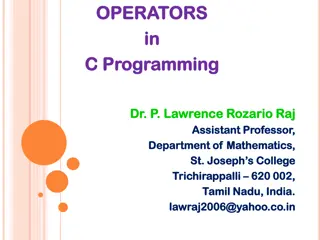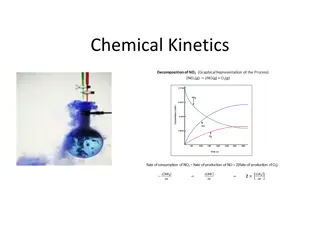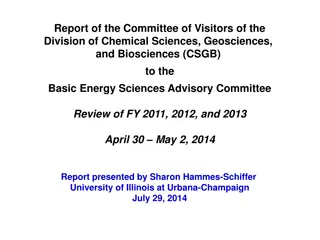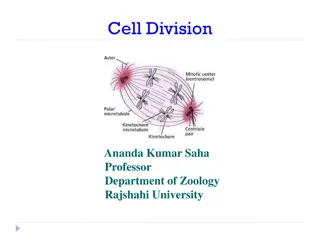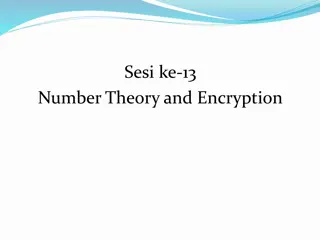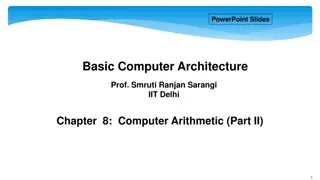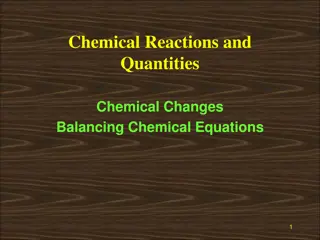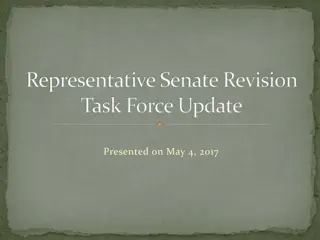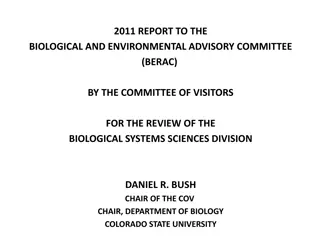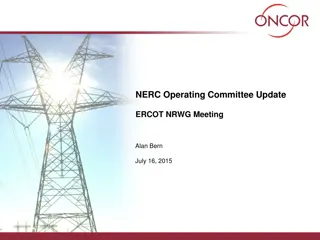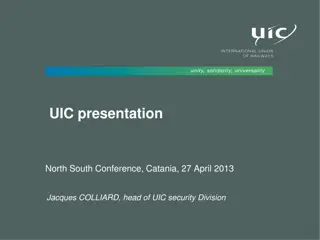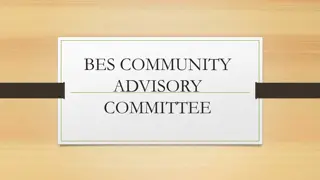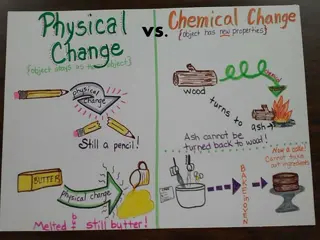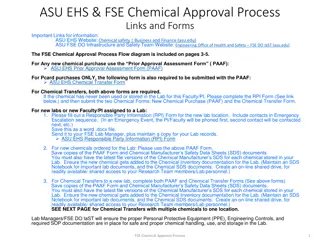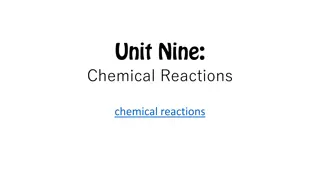Review of BES Chemical Sciences Division Update
The Committee of Visitors (COV) reviewed the Chemical Sciences, Geosciences, and Biosciences Division, emphasizing the importance of COVs in the BES practice. The COV's standard charge involves assessing proposal processes, project monitoring, and evaluating the impact of awards on portfolio breadth and national standing. The coverage included core research programs like Hydrogen Fuel Initiative, with a focus on molecular mechanisms of light capture and chemical transformations. The team structure in CSGB integrates physical science tools with biochemical systems for various applications.
Download Presentation

Please find below an Image/Link to download the presentation.
The content on the website is provided AS IS for your information and personal use only. It may not be sold, licensed, or shared on other websites without obtaining consent from the author.If you encounter any issues during the download, it is possible that the publisher has removed the file from their server.
You are allowed to download the files provided on this website for personal or commercial use, subject to the condition that they are used lawfully. All files are the property of their respective owners.
The content on the website is provided AS IS for your information and personal use only. It may not be sold, licensed, or shared on other websites without obtaining consent from the author.
E N D
Presentation Transcript
Committee of Visitors Review of the BES Chemical Sciences, Geosciences, and Biosciences Division Update for BESAC February 28, 2014 Michael Casassa Acting Director, Chemical Sciences, Geosciences and Biosciences Division
A Brief History of COVs in SC/BES The very first COV in SC was the review of the chemical sciences portion of the CSGB division in 2002. This is will be the fifth review for CSGB and the fourteenth COV review in BES. All previous COV reports and BES responses are archived on the SC/BES website for public view at http://science.energy.gov/bes/about/bes-cov/ COVs are now a standard part of BES practice and culture, and have been embraced by all offices in SC. COV recommendations are taken very seriously by BES and have resulted in substantive changes.
Committee of Visitor Charge (Standard) 1. For both the DOE laboratory projects and the university projects, assess the efficacy and quality of the processes used to: (a) solicit, review, recommend, and document proposal actions and (b) monitor active projects and programs. 2. Within the boundaries defined by DOE missions and available funding, comment on how the award process has affected: (a) the breadth and depth of portfolio elements, and (b) the national and international standing of the portfolio elements.
COV Coverage: FY 2011-2013 Covered Core research programs, including: Base program awards to universities and DOE labs The base program has incorporated renewals of awards made in earlier BES solicitations and expressions of interest: Hydrogen Fuel Initiative (HFI), Solar Energy Utilization (SEU), Nanoscale science (NSET), Chemical Imaging (CI), Single-Investigator and Small-Group Research (SISGR). New awards resulting from the FY2012 Expression of Interest (EOI) in Research Leading to Predictive Theory and Modeling for Materials and Chemical Sciences and from the FY2012 SciDAC Funding Opportunity Announcement (FOA). Not covered Energy Frontier Research Centers SC Early Career Awards SC Graduate Fellowship Program BES Equipment Supplement Program Fuels from Sunlight Energy Innovation Hub
Team Structure in CSGB Molecular mechanisms of light capture and its conversion to chemical and electrical energy via chemical and biochemical pathways Application of physical science tools to biochemical systems Photo- and Biochemistry Biomimetic catalytic systems Structural and dynamical studies of atoms, molecules, and nanostructures; description of their interactions with external stimuli (photons, electrons) at full quantum detail Characterization, control, and optimization of chemical transformations, from catalysis to geochemistry Fundamental Interactions Chemical Transformations Interfacial nanoscale chemistry Division-wide themes: chemical imaging; ultrafast chemical sciences; nanoscale science; interfacial science; theory, modeling, & simulation (including computation); synthesis
FY 2014 Committee of Visitors Sharon Hammes-Schiffer, University of Illinois, Chair April 30 May 2, 2014 at DOE Germantown 17 COV panelists organized into 3 panels Panelist statistics: Academia: 12 DOE Lab: 4 Industry: 1 International: 1 Funded by CSGB: 10 Not funded: 7 Male: 9 Female: 8 Chaka, Francisco, Winograd served on prior CSGB COVs Hammes-Schiffer, Kay are BESAC members
Panel Structure and Membership Panel 1: Fundamental Interactions Bruce Kay, PNNL, (Lead and BESAC) Heather Lewandowski - JILA/CU Joe Francisco Purdue University Gilbert Nathanson University of Wisconsin Rigoberto Hernandez Georgia Tech Panel 2: Photochemistry and Biochemistry Jim McCusker, Michigan State University (Lead) Greg Scholes University of Toronto Claudia Turro Ohio State University Lisa Utschig ANL Joan Broderick Montana State University Panel 3: Chemical Transformations Nick Winograd, Michigan State University (Lead) Giulia Galli University of Chicago Jim Rustad Corning Nicholas Delgass Purdue University Emily Smith Iowa State University Jackie Kipplinger LANL Anne Chaka PNNL (2008 COV Panelist)
Committee of Visitors Preparations Chair visited with the division on December 20, 2013 Met with division director, team leads, program managers Informed chair of division s programs Discussed process for COV Conference calls chair, panel leads, division director, and team leads Prior to COV to go over agenda, discuss process, and address concerns COV Website: Provides read ahead materials for COV panelists
COV Agenda Wednesday, April 30, 2014 Committee Members All Time Activity Division Staff Location 7:30 AM Travel from Fairfield Inn to DOE Drivers with cars Inn Lobby 8:00 AM Continental Breakfast Available All A-410 John Hemminger, Chair Basic Energy Sciences Advisory Committee Harriet Kung, Director Office of Basic Energy Sciences Michael Casassa, Acting Director Chemical Sciences, Geosciences, and Biosciences Division 8:30 AM Welcome and Charge to the Committee All A-410 8:40 AM Overview of Basic Energy Sciences All A-410 9:00 AMOverview of the Chemical Sciences, Geosciences, and Biosciences Division All A-410 9:30 AMUpdate on the SC Portfolio Analysis and Management System (PAMS) All TBD, Office of Science A-410 9:50 AM Review Procedures All TBD, Team Lead A-410 Sharon Hammes-Schiffer, Chair Committee of Visitors 10:15 AM Instructions and Schedule All A-410 10:30 AM Break and disperse to panel rooms First-Read Panel Members All 10:45 AM First Read Panel 1-3 CSGB Team Lead and Program Managers E-401, E-301, TBD A-410 Working Lunch All Panels Panel Rooms Resume First Read Panels 4:00 PM Preliminary Report Drafting Key Elements and Gaps Panels Panel Rooms Panel Leads and Chair 5:00 PM Meeting between Panel Leads and Chair TBD 5:30 PM Meeting with Chair and BES Senior Management Chair Harriet Kung, Michael Casassa TBD 6:00 PM Dinner for COV and BES Staff All All Nick s Chophouse
COV Agenda, contd. Thursday, May 1, 2014 Committee Members All All Time Activity Division Staff Location 7:45 AM Travel from Fairfield Inn to DOE 8:00 AM Continental Breakfast Available Drivers with cars InnLobby TBD Jeff Krause, Acting Team Lead Greg Fiechtner, Mark Pederson, Wade Sisk Gail McLean, Team Lead Chris Fecko, Mark Spitler, Bob Stack, Nada Dimitrijevic (detailee) John Miller, Team Lead Raul Miranda, Paul Maupin, Larry Rahn, Philip Wilk 8:30 AM Fundamental Interactions Team Session Panel 1 E-401 8:30 AM Photo- and Biochemistry Team Session Panel 2 TBD 8:30 AM Chemical Transformations Team Session Panel 3 E-301 9:15 AM Complete First Read Panel Reports Panels Panel Rooms COV Executive Session Reports from Panel Leads on First Read Reports All A-410 12:30 PM Lunch A-410 All Panel 1 Second Read Members Jeff Krause, Acting Team Lead Greg Fiechtner, Mark Pederson, Wade Sisk Second Read Panel 1 Fundamental Interactions Team 1:30 PM E-401 Gail McLean, Team Lead Chris Fecko, Mark Spitler, Bob Stack, Nada Dimitrijevic (detailee) John Miller, Team Lead Raul Miranda, Paul Maupin, Larry Rahn, Philip Wilk Panel 2 Second Read Members Second Read Panel 2 Photochemistry and Biochemistry 1:30 PM TBD Panel 3 Second Read Members Second Read Panel 3 Chemical Transformations 1:30 PM E-301 Merge First and Second Read Input Finalize Draft Panel Reports First Read Panels 4:00 PM Panel Rooms Dinner on your own All None On your own
COV Agenda, contd. Friday, May 2, 2014 Committee Members Time Activity Division Staff Location Fairfield Inn Lobby 7:45 AM Travel from Fairfield Inn to DOE Germantown All Drivers with cars 8:00 AM Continental Breakfast Available All A-410 8:30 AM COV Executive Session All A-410 Closeout Session with COV and BES Senior Management 9:15 AM All Harriet Kung, Michael Casassa A-410 10:00 AM Closeout Session with COV and BES Staff All All A-410 COV Chair meets with Panel Leads to begin drafting report COV Chair Panel Leads 10:45 AM A-410 COV Chair Panel Leads 12:30 PM Lunch A-410 COV Chair Panel Leads 2:00 PM Leave for airport from Germantown
Recommendations from past COVs The 2008 COV had a single recommendation: The COV recommends, in the strongest terms, the rigorous collection of data on all aspects of proposal solicitation, review, funding recommendation, proposed action and all metrics associated with progress that can assist in the evaluation of the impact of funded work. BES concurred and the response has been the development of a new system for SC: Portfolio Analysis and Management System (PAMS). This recommendation appeared in one form or another in every BES COV prior to 2008 in BES, and most in SC. As of November 2013, PAMS is now being used to manage solicitations, reviews, selections, and initiation of procurement requests. It is significantly changing how BES conducts its work. The 2014 CSGB COV will be the last paper COV.
Recommendations from past COVs The 2011 COV had three recommendations: Program Managers are encouraged to attend more national and international conferences and to make more visits to groups of researchers in their programs to spread the message of BES programs, to encourage wider participation, and to keep abreast of forefront research in their fields. BES concurred and has increased outreach, but travel has been increasingly restricted by appropriations. The COV recommends continued use of the procedures applied in the program to consider short preliminary statements of research ideas (white papers) and to provide rapid evaluations either encouraging researchers to submit full research proposals or consider modifying their plans. BES concurred. The COV recommends that BES provide web sites that are more accessible and encouraging than those currently available to those who might be interested in participating in the program and obtaining funding. BES concurred and has a new web presence as part of the revamping of the SC website. The website s continued evolution includes accessible information about BES programs and funding opportunities.
EOI and SCiDAC Awards Research Leading to Predictive Theory and Modeling for Materials and Chemical Sciences - Expression of Interest and Awards Materials and Chemistry by Design A total of $13M in new funding was provided in FY2012 ($3M one-time) to support 5 centers and 10 smaller grants in BES (2 centers and 6 smaller grants in CSGB) SciDAC Partnerships in Computational Materials and Chemical Sciences - Funding Opportunity Announcement and Awards First-principles treatments of excited states and excited states processes; electron correlation in finite and extended systems; applications in solar energy, chemical reactions, magnetism and superconductivity, materials under extreme environments, separations, and energy storage A total of $6.4M in new funding was provided in FY2012 for 7 BES-ASCR partnerships. CSGB, MSE, and ASCR are about equally invested in these partnerships. CSGB participates in 4. (10 ) (57)




